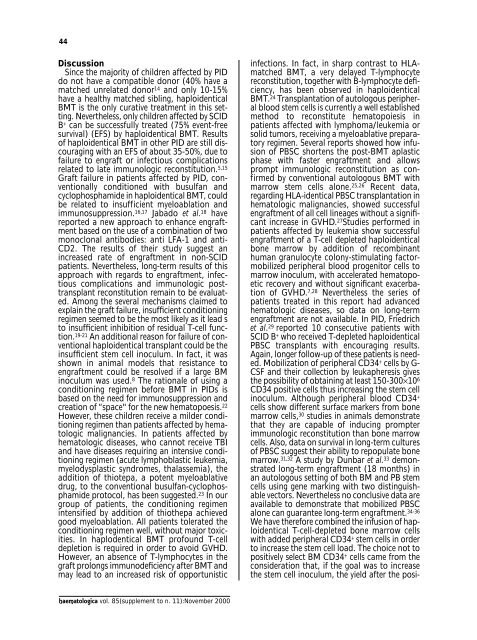Journal of Hematology - Supplements - Haematologica
Journal of Hematology - Supplements - Haematologica
Journal of Hematology - Supplements - Haematologica
Create successful ePaper yourself
Turn your PDF publications into a flip-book with our unique Google optimized e-Paper software.
44<br />
Discussion<br />
Since the majority <strong>of</strong> children affected by PID<br />
do not have a compatible donor (40% have a<br />
matched unrelated donor 14 and only 10-15%<br />
have a healthy matched sibling, haploidentical<br />
BMT is the only curative treatment in this setting.<br />
Nevertheless, only children affected by SCID<br />
B + can be successfully treated (75% event-free<br />
survival) (EFS) by haploidentical BMT. Results<br />
<strong>of</strong> haploidentical BMT in other PID are still discouraging<br />
with an EFS <strong>of</strong> about 35-50%, due to<br />
failure to engraft or infectious complications<br />
related to late immunologic reconstitution. 5,15<br />
Graft failure in patients affected by PID, conventionally<br />
conditioned with busulfan and<br />
cyclophosphamide in haploidentical BMT, could<br />
be related to insufficient myeloablation and<br />
immunosuppression. 16,17 Jabado et al. 18 have<br />
reported a new approach to enhance engraftment<br />
based on the use <strong>of</strong> a combination <strong>of</strong> two<br />
monoclonal antibodies: anti LFA-1 and anti-<br />
CD2. The results <strong>of</strong> their study suggest an<br />
increased rate <strong>of</strong> engraftment in non-SCID<br />
patients. Nevertheless, long-term results <strong>of</strong> this<br />
approach with regards to engraftment, infectious<br />
complications and immunologic posttransplant<br />
reconstitution remain to be evaluated.<br />
Among the several mechanisms claimed to<br />
explain the graft failure, insufficient conditioning<br />
regimen seemed to be the most likely as it lead s<br />
to insufficient inhibition <strong>of</strong> residual T-cell function.<br />
19-21 An additional reason for failure <strong>of</strong> conventional<br />
haploidentical transplant could be the<br />
insufficient stem cell inoculum. In fact, it was<br />
shown in animal models that resistance to<br />
engraftment could be resolved if a large BM<br />
inoculum was used. 8 The rationale <strong>of</strong> using a<br />
conditioning regimen before BMT in PIDs is<br />
based on the need for immunosuppression and<br />
creation <strong>of</strong> “space" for the new hematopoesis. 22<br />
However, these children receive a milder conditioning<br />
regimen than patients affected by hematologic<br />
malignancies. In patients affected by<br />
hematologic diseases, who cannot receive TBI<br />
and have diseases requiring an intensive conditioning<br />
regimen (acute lymphoblastic leukemia,<br />
myelodysplastic syndromes, thalassemia), the<br />
addition <strong>of</strong> thiotepa, a potent myeloablative<br />
drug, to the conventional busulfan-cyclophosphamide<br />
protocol, has been suggested. 23 In our<br />
group <strong>of</strong> patients, the conditioning regimen<br />
intensified by addition <strong>of</strong> thiothepa achieved<br />
good myeloablation. All patients tolerated the<br />
conditioning regimen well, without major toxicities.<br />
In haplodentical BMT pr<strong>of</strong>ound T-cell<br />
depletion is required in order to avoid GVHD.<br />
However, an absence <strong>of</strong> T-lymphocytes in the<br />
graft prolongs immunodeficiency after BMT and<br />
may lead to an increased risk <strong>of</strong> opportunistic<br />
infections. In fact, in sharp contrast to HLAmatched<br />
BMT, a very delayed T-lymphocyte<br />
reconstitution, together with B-lymphocyte deficiency,<br />
has been observed in haploidentical<br />
BMT. 24 Transplantation <strong>of</strong> autologous peripheral<br />
blood stem cells is currently a well established<br />
method to reconstitute hematopoiesis in<br />
patients affected with lymphoma/leukemia or<br />
solid tumors, receiving a myeloablative preparatory<br />
regimen. Several reports showed how infusion<br />
<strong>of</strong> PBSC shortens the post-BMT aplastic<br />
phase with faster engraftment and allows<br />
prompt immunologic reconstitution as confirmed<br />
by conventional autologous BMT with<br />
marrow stem cells alone. 25,26 Recent data,<br />
regarding HLA-identical PBSC transplantation in<br />
hematologic malignancies, showed successful<br />
engraftment <strong>of</strong> all cell lineages without a significant<br />
increase in GVHD. 27 Studies performed in<br />
patients affected by leukemia show successful<br />
engraftment <strong>of</strong> a T-cell depleted haploidentical<br />
bone marrow by addition <strong>of</strong> recombinant<br />
human granulocyte colony-stimulating factormobilized<br />
peripheral blood progenitor cells to<br />
marrow inoculum, with accelerated hematopoetic<br />
recovery and without significant exacerbation<br />
<strong>of</strong> GVHD. 7,28 Nevertheless the series <strong>of</strong><br />
patients treated in this report had advanced<br />
hematologic diseases, so data on long-term<br />
engraftment are not available. In PID, Friedrich<br />
et al. 29 reported 10 consecutive patients with<br />
SCID B + who received T-depleted haploidentical<br />
PBSC transplants with encouraging results.<br />
Again, longer follow-up <strong>of</strong> these patients is needed.<br />
Mobilization <strong>of</strong> peripheral CD34 + cells by G-<br />
CSF and their collection by leukapheresis gives<br />
the possibility <strong>of</strong> obtaining at least 150-300×10 6<br />
CD34 positive cells thus increasing the stem cell<br />
inoculum. Although peripheral blood CD34 +<br />
cells show different surface markers from bone<br />
marrow cells, 30 studies in animals demonstrate<br />
that they are capable <strong>of</strong> inducing prompter<br />
immunologic reconstitution than bone marrow<br />
cells. Also, data on survival in long-term cultures<br />
<strong>of</strong> PBSC suggest their ability to repopulate bone<br />
marrow. 31,32 A study by Dunbar et al. 33 demonstrated<br />
long-term engraftment (18 months) in<br />
an autologous setting <strong>of</strong> both BM and PB stem<br />
cells using gene marking with two distinguishable<br />
vectors. Nevertheless no conclusive data are<br />
available to demonstrate that mobilized PBSC<br />
alone can guarantee long-term engraftment. 34-36<br />
We have therefore combined the infusion <strong>of</strong> haploidentical<br />
T-cell-depleted bone marrow cells<br />
with added peripheral CD34 + stem cells in order<br />
to increase the stem cell load. The choice not to<br />
positively select BM CD34 + cells came from the<br />
consideration that, if the goal was to increase<br />
the stem cell inoculum, the yield after the posi-<br />
haematologica vol. 85(supplement to n. 11):November 2000

















